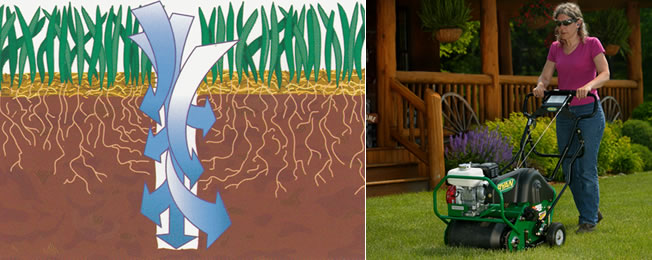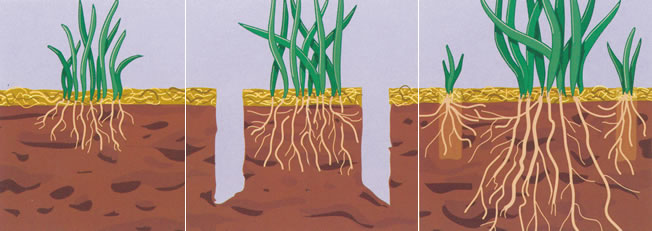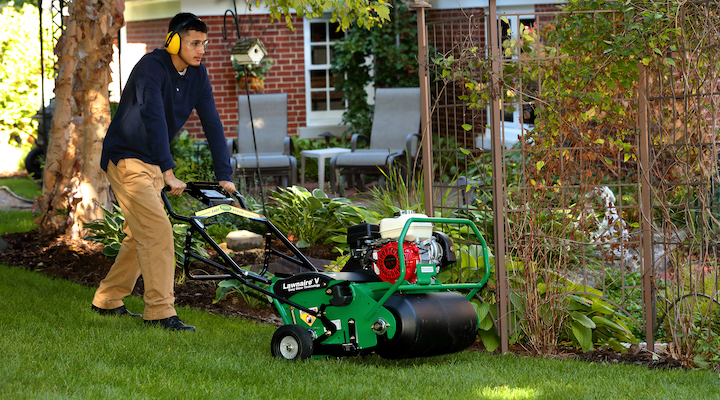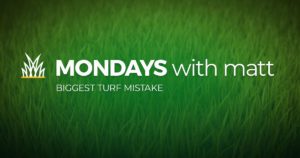LAWN AERATION
Removing small cores of soil from your lawn reduces soil compaction and promotes root growth for healthier grass!
WHAT IS AERATION?
Technically speaking, aeration is the naturally occurring process of air exchange between the soil and its surrounding atmosphere. Practically speaking, aeration is the process of mechanically removing small plugs of thatch and soil from the lawn to improve natural soil aeration. It’s commonly called “core aeration” in the lawn service industry, and you may have heard of it as soil cultivation (coring, spiking and slicing). Most homeowners simply call it aeration.
WHAT ARE THE BENEFITS OF AERATION?
Core aeration can help make your lawn healthier and reduce its maintenance requirements through these means:
- Improved air exchange between the soil and atmosphere.
- Enhanced soil water uptake.
- Improved fertilizer uptake and use.
- Reduced water runoff and puddling.
- Stronger turfgrass roots.
- Reduced soil compaction.
- Enhanced heat and drought stress tolerance.
- Improved resiliency and cushioning.
- Enhanced thatch breakdown.


ROOT GROWTH – Core aeration allows air, water and fertilizer to better reach the root zone. This stimulates root growth to create healthier, stronger turfgrass plants.
AERATION EQUIPMENT AFFECTS THE OUTCOME…
The type of aeration equipment can determine how effective the treatment will be. In general, turf responds best when core holes are close and deep. Equipment with hollow tines removes soil cores. Equipment with open tines divots the soil surface. Aeration equipment also varies in tine size up to 3/4 inch diameter and in depth of penetration up to 4 inches, depending on the manufacturer’s specifications.
WHY IS AERATION NECESSARY?
Compact soil prevents grass from establishing a healthy root system and keeps water and fertilizer from reaching the roots.
In most home lawns, fertile topsoil may have been removed or buried during excavation of the basement or footings, forcing grass to grow in subsoil that is more compact, higher in clay content and less likely to sustain a healthy lawn.
Walking, playing and mowing will compact soil and stress lawns. Raindrops and irrigation further compact the soil, reducing large air spaces where roots readily grow. Compaction is greater on heavy clay soils than on sandy soils, and it is greatest in the upper 1 to 1 1/2 inches of soil.
Aeration can help relieve soil compaction, allowing your grass to grow deeper roots and make better use of water and fertilizer.


Soil Compaction – Turfgrass in compacted soil (left) grows slowly, lacks vigor and becomes thin or does not grow at all. Core aeration (center) removes small cores of soil, depositing them on the surface of the turf. This improves the depth and the extent of turfgrass rooting (right), and it can help save money on your water bill.
RELIEVE THATCH ACCUMULATION
Most home lawns are subject to thatch accumulation. Left unmanaged, it impedes water, fertilizer and pesticide effectiveness. Core aeration combines soil with the thatch debris, so soil organisms are better able to break down the thatch and reduce its accumulation.


Thatch Buildup – Although a thin layer of thatch is beneficial, thatch accumulation should not exceed 1/2 inch. Excess thatch blocks out air, light and water from reaching root zones. Core aeration reduces thatch accumulation and minimizes its buildup.
HOW OFTEN SHOULD LAWNS BE AERATED?
Most home lawns benefit from annual aeration. Heavily used lawns, or those growing on heavy clay or subsoils may need aeration twice a year. Golf fairways, sports turf and municipalities may need aeration three to five times per year depending on the amount of use. Again, turf responds best when tine spacing is closer and penetration is deeper.
WHEN IS THE BEST TIME TO AERATE?
If you have cool season turfgrass such as Kentucky bluegrass and perennial ryegrass, both spring and fall are ideal times to aerate. In spring, aerate between March and May. Perform fall aeration between August and November. Aeration before or at the time of late season fertilization enhances root growth and improves spring greenup and growth.
Warm season turfgrasses such as zoysiagrass and bermudagrass should be aerated in mid-spring to summer. Avoid aerating when warm season grasses are dormant – it may encourage weed competition. In addition, avoid aerating warm season grasses during spring greenup, and not until after their first spring mowing.
HERBICIDES, FERTILIZERS & AERATION
It’s best to aerate before you apply pre-emergence herbicides, rather than after. Aerating after a herbicide application can reduce the chemical barrier formed by the herbicide, allowing weeds to germinate. Applying fertilizer after aeration helps the lawn compete against weeds. Water the lawn after aeration, particularly in areas where drought and high temperatures are common.
WHAT CAN YOU EXPECT?
Immediately after aeration, your lawn will be dotted with small plugs pulled from the soil. Within a week or two, they break apart and disappear into the lawn.
About 7 to 10 days after aeration, the aerification holes will be filled with white, actively growing roots – a sign that the turfgrass is receiving additional oxygen, moisture and nutrients from the soil.
On compacted soils and on lawns with slopes, you should see an immediate difference in water puddling and runoff after irrigation or rainfall. After aeration, your lawn should be able to go longer between waterings, without showing signs of wilt. With repeat aerations over time, your lawn will show enhanced heat and drought stress tolerance.
Remember, most lawns benefit from annual aeration. And while you shouldn’t expect miracles, especially with poor soil, lawns that receive this care will be healthier, more vigorous, easier to maintain and have fewer pest problems.
USEFUL DEFINITIONS
COMPACTION: A condition that occurs primarily in the upper 1 to 1 1/2 inches of soil. Compacted soils have reduced air spaces and more resistance to root growth than noncompacted soils. Compacted soils are dense and cause water to puddle and run off.
Core Aeration: The mechanical removal of small plugs of soil and thatch from the lawn.
Dethatching: The process of removing the thatch layer from turf, the layer of dead and decaying plant tissue located between the soil surface and the green vegetation. This process is usually done mechanically with a dethatching unit or power rake.
Power Rake: Turf equipment that mechanically removes thatch with rigid wire tines or steel blades, which slice through the turf and lift the thatch debris to the surface for removal.
Thatch: The layer of dead and decaying plant tissue located between the soil surface and the green vegetation. A thin layer of thatch is beneficial because it reduces soil compaction and it increases wear tolerance. However, a thatch layer of 1/2 inch or more prevents air, light and water from reaching the turf’s root zone. Thatch also makes an excellent breeding ground for harmful insects and disease organisms.
Learn more about Ryan® Walk-Behind Aerators and Tow-Behind Aerators, then find your nearest Ryan® Dealer.



